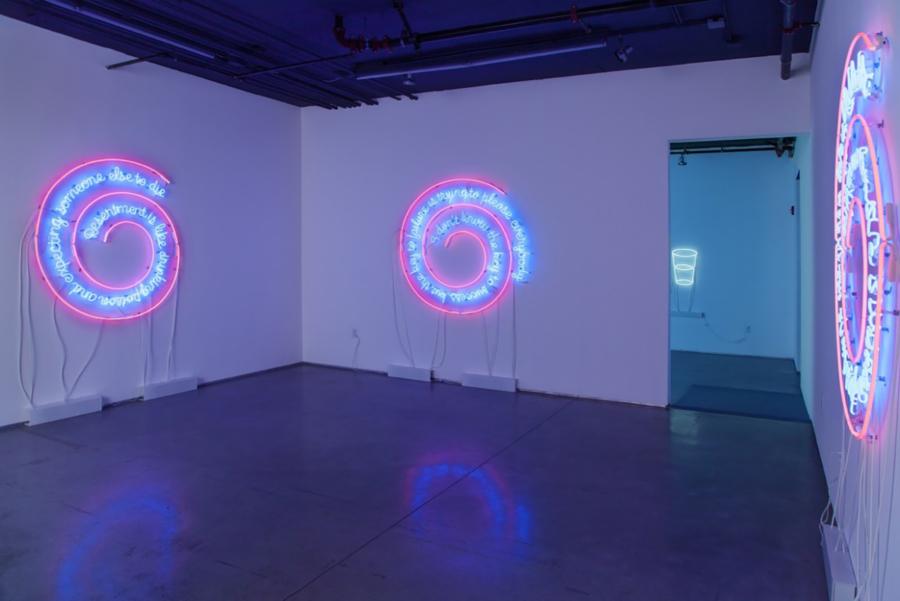October 20, 2014
Download as PDF
View on Art Practical

Mungo Thomson. Wall, Window or Bar Signs, 2014; installation view, Kadist Art Foundation. Courtesy of the Artist and Kadist Art Foundation, San Francisco. Photo: Jeff Warrin.
When Bruce Nauman finished his MFA at the University of California at Davis in 1966, he chose San Francisco as the site for his first studio, in a building not far from Kadist Art Foundation’s current home. Here Nauman made some of his first works in neon, including The True Artist Helps the World by Revealing Mystic Truths (1967), a sculpture of peach and blue neon and clear glass tubing inspired by neon bar signs and intended for placement in a window or on a wall. In the exhibition Wall, Window or Bar Signs, currently on view at Kadist, Mungo Thomson riffs on the form of Nauman’s iconic neon sign, substituting motivational language appropriated from 12-step and self-help literature in place of Nauman’s text.
The impulse when walking through the exhibition is to move quickly: The six neon sculptures, commissioned for the exhibition by Kadist, share an identical peach spiral and blue script with different texts. Like Nauman before him, Thomson does not hide the technical apparatus (the white wires that connect to the transformer plugged into the wall), but rather leaves exposed the electrical elements that make the sculpture operate. Though large-scale, almost like glowing mirrors, the sentiments expressed in the exhibition, such as “As you go through life make this your goal, watch the donut not the hole,” ring hollow. Thomson’s hackneyed texts are so immediately identifiable to viewers as to be meaningless.
More interesting than the neon signs themselves is the accompanying limited-edition artist book, The Big Book, designed to mimic the identically titled The Big Book, the collection of personal anecdotes and solutions to alcoholism that became the foundational text of Alcoholics Anonymous in 1939. Thomson worked closely with designer Jon Sueda/Stripe SF and typographer James Edmondson to produce a comprehensive font alphabet based on Nauman’s original neon script. Thomson’s Bible-like tome has a blue leather cover with the title embossed in all caps. The weighty book fits nicely in the hands like a hymnal, and contains within its pages hundreds more peach spirals with witty aphorisms and trite wisdom printed in blue text. Flipping through the book, viewers will be surprised to see how many of the phrases fit comfortably within the confines of Nauman’s shape: Thomson’s irony condenses the mystery of life into a neat spiral.
Thomson’s interest in Nauman’s iconic work is not new. As an MFA student at UCLA in 1999, Thomson created vinyl bumper stickers featuring Nauman’s original text and modeled on rehabilitation-program products, and distributed them among his peers. Curator Joseph del Pesco’s text for the exhibition explains that Thomson was motivated by a fascination with public displays of private struggles. A shortcoming of this latest iteration of the artist’s investigation of Nauman’s legacy is that Thomson’s clichés elicit little more than a polite chuckle. Nauman employed neon signs to interrogate sculptural modes of presentation, and the text he chose was both tongue-in-cheek in its reference to the artist myth and evocative of the power of art to transcend the everyday. Thomson, on the other hand, connects us to something smaller. Perhaps he needs to heed the advice given in one of his sculptures, whose spiral of letters reads, “Insanity is doing the same thing over and over and expecting different results.”



